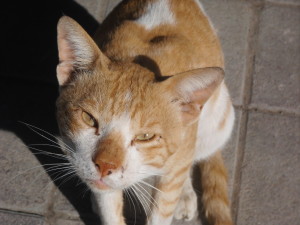
Many years ago, I decided to write a book about cats for younger and general readers (it’s no academic tome, folks). It never quite got finished, and was never published. But I’ve decided to publish some of it here, lest someone on the webs has an interest in picking it (or, indeed, me) up.
Does your cat think it is a god? Perhaps it’s because he or she has a genetic memory of ancient Egyptian times, when humans worshipped a cat goddess variously known as Bastet, Bast or Ubasti. A daughter of the god Ra (or Re), she was variously depicted as having the head of a domestic cat or of a lion. Like all felines, the goddess had two sides to her personality: aggressive and docile. Her gentle side shone through in her roles as protector of the home and pregnant women, but she was also associated with slaughter in time of war.
The cult of Bastet was centred in Bubastic, 80km northeast of Cairo near modern-day Zagazig, and the goddess’s festival was described in some detail by 4th Century BC Greek writer Herodotus. Apparently male and female devotees would sail together up the Nile, stopping at various towns mocking the locals — oh, what jolly fun! — until they arrived at Bastet, where the real party began. Herodotus noted that 700,000 people made the pilgrimage annually and that “and more wine of grapes is consumed upon that festival than during the whole of the rest of the year”.
It was also in Egypt that the cat was domesticated. Tomb paintings from the New Kingdom (1540 to 1069 BC) show cats retrieving birds and fish for their humans, or relaxing inside a home. The importance of cats in ancient Egypt is also evident from the widespread mummification of dead animals and the creation of cat statues, jewellery and ornaments. Herodotus noted that “in whatever houses a cat has died by a natural death, all those who dwell in this house shave their eyebrows … the cats when they are dead are carried away to sacred buildings in the city of Bubastis, where after being embalmed they are buried”.
It is recorded that the cat was so sacred to Egyptians that, in the fifth century BC, the Persian King Cambyses was able to defeat them by ordering his soldiers to attach live cats to their shields. The Egyptians would not attack the Persians for fear of hurting the sacred cats, and so they surrendered.
There is also a little-known Christian link to the cat. One story of the birth of Jesus Christ says the baby had trouble sleeping and his mother Mary appealed to the other animals in the stable for help. A small grey kitten, the progeny of a tabby cat who had also given birth in the stable, climbed up into the manger and snuggled into the baby Jesus, who then fell asleep. Mary was so pleased that she rewarded all tabbies from that time forward to wear the letter M, for Madonna, on their foreheads. Another story tells how St Agatha appeared as an angry cat to a woman who failed to observe her feast day.
References: April McDevitt, Egyptianmyths.net, Bastet (Bast), 1997-2005; Herodotus (translated G.C. Macaulay), An Account of Egypt; Ilene Springer, The Cat in Ancient Egypt, Tour Egypt Monthly, April, 2001; Roni Jay, The Kingdom of the Cat, New Holland, 2000
